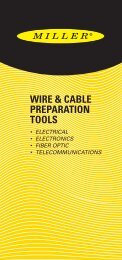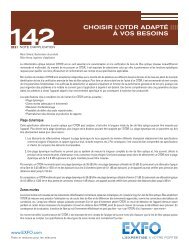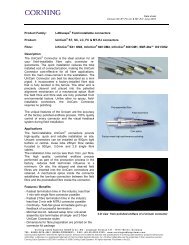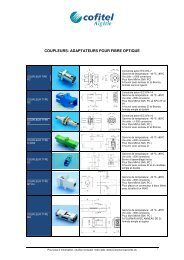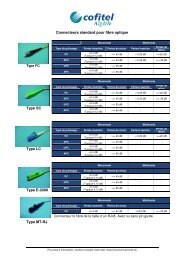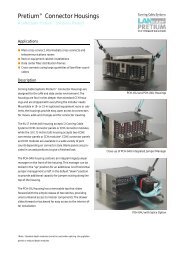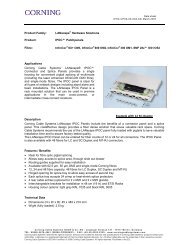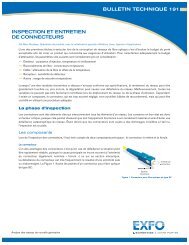Sélection d'un câble de fibre optique (fr) - info@c3comunicaciones.es
Sélection d'un câble de fibre optique (fr) - info@c3comunicaciones.es
Sélection d'un câble de fibre optique (fr) - info@c3comunicaciones.es
- No tags were found...
Create successful ePaper yourself
Turn your PDF publications into a flip-book with our unique Google optimized e-Paper software.
L<strong>es</strong> <strong>câble</strong>s fournis habituellement par l<strong>es</strong> différents fabricants sont généralement construis avec<strong>de</strong>s <strong>fibre</strong>s du type inclus dans la première ligne du Tableau 1, c'<strong>es</strong>t pour cela tout autre type <strong>de</strong>vraêtre indiqué expr<strong>es</strong>sémentFibre <strong>optique</strong> Multi mo<strong>de</strong>: Utilisée habituellement dans <strong>de</strong>s réseaux locaux (LAN), <strong>de</strong>télésurveillance ou <strong>de</strong> sécurité. Sa définition se compose <strong>de</strong> trois parti<strong>es</strong>: MM (Sigl<strong>es</strong>corr<strong>es</strong>pondants à la dénomination Multi mo<strong>de</strong>) Relation noyau/revêtement (Normalement 50/125ou 62,5/125) Type <strong>de</strong> <strong>fibre</strong>: OM1, OM2 ou OM3 d´après le tableau suivant:Distance 100BaseT 1000 Base Sx 1000 Base Lx 10G Base SR/SWOF300 OM1 OM2 OM1/OM2 OM3OF 500 OM1 OM2 OM1/OM2 SMOf 2000 OM1 SM SM SMTableau 2: Type <strong>de</strong> <strong>fibre</strong> en fonction <strong>de</strong> la longueur <strong>de</strong> la liaison EthernetL<strong>es</strong> réseaux hors LAN (contrôle industriel et vidéo ban<strong>de</strong> base) utilisent <strong>de</strong>s <strong>fibre</strong>s MM (typ<strong>es</strong> OM1ou OM2 indistinctement), <strong>de</strong> 62,5/125 ou 50/125 en fonction <strong>de</strong> la distance à atteindre.Le noyau <strong>optique</strong>: Typ<strong>es</strong> <strong>de</strong> constructionsPour pouvoir protéger convenablement l<strong>es</strong> <strong>fibre</strong>s <strong>optique</strong>s (contre l'humidité, résistance à latraction, etc.) et ainsi constituer la base <strong>d'un</strong> <strong>câble</strong>, on dispose <strong>de</strong> <strong>de</strong>ux systèm<strong>es</strong> :Construction serrée. Elle consiste à placer sur chaque <strong>fibre</strong> individuelle une protection plastiquepar extrusion directe, jusqu'à obtenir un diamètre <strong>de</strong> 900 µm.D<strong>es</strong> filatur<strong>es</strong> d'Arami<strong>de</strong> ou <strong>fibre</strong> <strong>de</strong> verre sont placé<strong>es</strong> au tour <strong>de</strong>s <strong>fibre</strong>s pour atteindre larésistance à la traction néc<strong>es</strong>saire, et le <strong>câble</strong> <strong>es</strong>t construit sur cette base.Son principal avantage <strong>es</strong>t une protection optimale anti-humidité ainsi qu'une flexibilité et unerésistance mécanique considérabl<strong>es</strong>.Son principal inconvénient <strong>es</strong>t la difficulté à utiliser, par <strong>de</strong>s raisons d´encombrement, <strong>de</strong>s <strong>câble</strong>s<strong>de</strong> plus <strong>de</strong> 24 <strong>fibre</strong>s.Figure 1: D<strong>es</strong>cription <strong>d'un</strong> <strong>câble</strong> <strong>de</strong> structure serrée1. Fibre <strong>optique</strong> (Noyeau + revétement: 250 ou 500 µm)2. Protection mécanique (900 µm)3. Arami<strong>de</strong> ou <strong>fibre</strong> <strong>de</strong> verre4. Gaine (LSZH, PE, etc.)Page 2/8



